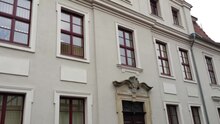Jenny Marx House
The Jenny Marx House is the birthplace of Jenny Marx , the wife of Karl Marx . It is located at Jenny-Marx-Straße 20 in Salzwedel ( Saxony-Anhalt ).
history
The mayor Joachim Valentin Ludolph Niedt (1701–1768) built a two-storey house in 1737 on the foundation walls of two previous buildings. It initially bore the house number 136/137 according to a historical counting method of the city. The descendants of Niedts sold the house in 1808 to the sub-prefect of Bülow , who set up the administration of the state parliament in it. Just one year later, Ludwig von Westphalen took over the building as the new sub-prefect with his wife Caroline von Westphalen, née Heubel (1780–1856). She gave birth to her daughter Jenny on February 12, 1814 in the house. Two years later the house was privately owned again until 1851, after her father was transferred to Trier as a member of the government in 1816 . During this time there was, among other things, a brewery with a bar in the building. The Landtag administration then rented the building again and finally bought it in 1854. In 1878 it was given the address Lorenzstrasse 20 . From 1866 a regiment of the Uhlans was quartered in Salzwedel . They needed the building from 1880 to 1920 and set up a hospital in it . After this time it served again as the seat of the district administration. In 1934, the administration expanded the attic and installed the gables on the street and courtyard side that were still present in 2015 .
In 1949 - on the 135th birthday of the famous daughter of the city of Salzwedel - the administration renamed Lorenzstraße to Jenny-Marx-Straße . At the same time she set up a small memorial. In 1968 and 1969 it was expanded into a museum about the Marx family . For the 150th birthday of Karl Marx, the city presented the first part to the public on May 5, 1968. The rest of the museum building was opened on September 26, 1969, on the 20th anniversary of the GDR . It was considered the political education center in the entire district and was the destination of numerous delegations. In October 1984 the curators moved the bronze statue Jenny by the sculptor Heinrich Apel from Magdeburg from the museum to the newly designed garden of the museum. The custom arose among bridal couples in the city to place their bouquets there after the wedding.
After the fall of the Wall, the administration attached the museum to the Johann-Friedrich-Danneil-Museum . The majority of the premises served from then on as a school museum and for temporary exhibitions; only one memorial room remained. In 2005 the district music school moved into the house and kept this room. In May 2011, the city expanded the exhibition to two rooms on the ground floor.
The building is part of the Frauenorte project , which aims to honor strong women in Germany and their life's work as historical role models.
literature
- Johanna C. Newcomer: Jenny - familiar stranger . Ed .: "Festkomitees Jenny 200", Martin Hoffman. KulTour operation, Salzwedel 2014 (24 p, salzwedel.de [PDF; 2.3 MB ]).
- Ulrich Kalmbach, Angelika Limmroth, Rolf Hecker : Jenny Marx 1814–1881. A courageous woman between Salzwedel and London . Museums des Altmarkkreises, Salzwedel 2014, DNB 1047891468 (catalog for the permanent exhibition in the Jenny-Marx-Haus).
Web links
- The birth house in Salzwedel , website of the Friends of Jenny Marx, accessed on April 8, 2015.
- Jenny Marx House in Salzwedel
Individual evidence
- ↑ Wolfgang Schwalbach: Looking at Jenny and Karl Marx with today's view , interview with the former director of the Jenny Marx memorial, published in "Jenny - familiar unknowns".
- ↑ There's really something going on here. In: Der Spiegel 33/1992, accessed on April 13, 2015
- ↑ Jenny Marx. A courageous woman between Salzwedel and London , information about the book on the museum page
Coordinates: 52 ° 51 ′ 0.5 ″ N , 11 ° 8 ′ 55.6 ″ E


